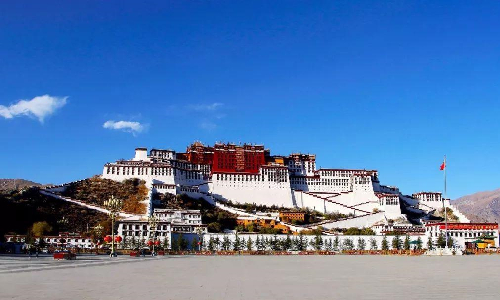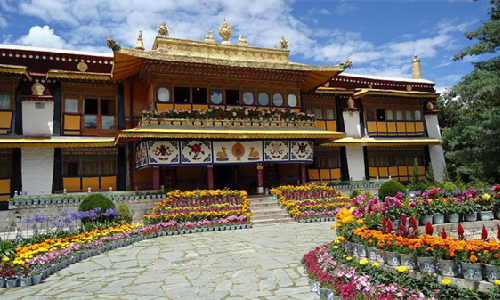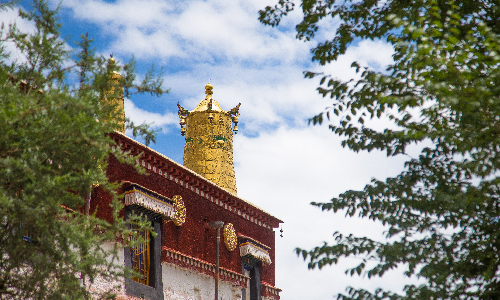If you are looking for a short Tibet tour, this 3-day Tibet Lhasa tour is the best choice for you. Lhasa, as the capital of Tibet, is one of the must-visit Tibet tourist places that you cannot miss. During your Lhasa sightseeing tour, the most renowned Lhasa tourist attractions are waiting for you to explore one by one. You will visit the Potala Palace first to admire the magnificent royal palace of Tubo Kingdom, where Songtsan Gampo and Princess Wencheng once lived. The summer palace of Dalai Lamas – Norbulingka is also included to show you a picturesque Tibetan garden. In addition, you will enter the holiest Tibetan Buddhist monasteries, namely, Jokhang Temple, Drepung Monastery, and Sera Monastery, to pray for the divine guidance of the Buddha and purify your spirit. Throughout this Tibet Lhasa tour, you will get a full depiction of Lhasa and Tibet. Come and unlock the mysterious Tibet with us!

Welcome to Lhasa! When you arrive at Lhasa airport, you will meet a professional guide who will be waiting for you at the arrival lobby with your name sign. Then you will be transferred to a local hotel to have a good rest. The guide will help you with your check-in and luggage.
Lhasa is the capital city of Tibet, an ethnic autonomous region located in southwest China. With an average altitude of over 4,000 meters, Tibet is known as the “roof of the world”. The average altitude of Lhasa is about 3,650 meters so you may suffer from the high-altitude reaction syndrome featuring insomnia, hypoxia, and headache. For your safety, you should report any discomforts to the guide and follow the doctor’s advice to take specific drugs. The city is abundant with sunshine, so it is suggested to take protective products such as sunglasses, sunhats, and UPF clothes. However, the high altitude and strong sunshine are belittled by the beautiful sceneries of the city. Boasting brilliant Buddhist culture and unique plateau landscapes, Lhasa is listed as the Excellent Tourism City of China. So, get ready to explore the wonderland.
After having breakfast at the hotel, you will visit the first tourist attraction of the trip: the Potala Palace. It is a magnificent castle-style palace comprising the White Palace and the Red Palace with their ancillary buildings. It is built on the Red Mountain at an altitude of over 3,700 meters. With a history of more than 1,300 years, the complex was built under the order of Songtsan Gampo (the leader of the Tubo Kingdom or the Tibetan Kingdom) to marry Princess Wencheng from the Tang Dynasty (618-907). Their marriage greatly contributed to the development of Tibet and the peace between Tibet and the Tang Dynasty by exchanging cultures and technologies. In the 17th century, it was converted into the winter palace of the Dalai Lamas, symbolizing the unification of the political power and Tibetan Buddhism. Except for its historical and religious values, the palace is also reputed for its architectural aesthetics. It perfectly matches the mountain slopes, making it spectacular. The Potala Palace was listed in the World Cultural Heritages by UNESCO in 1994.
After a lunch break, we will visit Jokhang Temple. The 1,300-year-old temple, located at the center of Lhasa, is the religious center of Tibet and the holiest destination for all Tibetan Buddhist pilgrims. The architectural style of the temple combines Indian, Tibetan, and Nepalese designs. It is said that the temple was built in the 7th century to house the sacred statue of Buddha Sakyamuni brought by Princess Bhrikuti Devi of Nepal, the first wife of Songtsan Gampo. According to the legend, the site of the Jokhang Temple was originally a lake. King Songtsan Gampo promised Princess Bhrikuti Devi to build a Buddhist temple, so he threw his ring into the air to pray to the Buddha for telling him where to build the temple. Unexpectedly, the ring just fell into the lake. Suddenly, the lake was covered with an aureole, and a nine-story white pagoda came out of the water in the center of the aureole. Thus, Songtsan Gampo chose this place to build the Jokhang Temple around the white pagoda.
Then we will walk along Barkhor Street, a street built around the Jokhang Temple. At first, it was a beaten pathway by numerous pilgrims who came to the temple. Gradually, it is developed into a thriving bazaar. For Tibetans, it is a sacred street. So, you will find pilgrims walking along the street clockwise to show their worship to Sakyamuni Buddha enshrined in the Jokhang Temple. In the street, you can also find ancient buildings, local snacks, famous restaurants, and various Tibetan handicrafts. In addition, commodities from India, Nepal, and Myanmar are also sold in this street.

After breakfast, we will visit Norbulingka. Norbulingka, on the west edge of Lhasa city, is the biggest man-made garden in Tibet. In the Tibetan language, “Norbulingka” means “Park of Treasure”. It is a typical Tibetan-style garden and the summer palace of Dalai Lamas. It was constructed in the 1840s, and after more than 200 years of expansion, the whole garden covers an area of 360,000 square meters with 374 rooms. There are more than 100 kinds of plants, including local flowers and trees and exotic ones from the vicinity of the Himalayas. Moreover, the Sho Dun Festival (a traditional religious festival for all the Tibetans) held in the palace is most famous. In Tibetan, “Sho” means yogurt, and “Ton” means banquet. Therefore, it is a feast of eating yogurt. The festival starts in late June or early July of the Tibetan calendar, which usually is in August of the solar calendar. People will have a picnic, watch the traditional Tibetan Opera, chant scriptures, and offer white Hada during the festival.
Then we will drive for about 20 minutes westward to Drepung Monastery. It is one of the three greatest Gelug (one major school of Tibetan Buddhism) monasteries, along with Sera Monastery and Ganden Monastery. It is on the Gambo Utse Mountain and is a magnificent complex of white buildings. From distance, it looks like a huge pile of rice which is the meaning of “Drepung” in Tibetan. As the largest monastery of Tibet, Drepung Monastery constructed in 1416 plays an important role in Tibet Buddhism. Throughout its history, many important Tibetan leaders used to study here, especially the Dalai Lamas. For this reason, the monastery is acclaimed as the “Mother Monastery of Dalai Lamas”. In addition, it is also a center to celebrate Sho Dun Festival. So, if you miss out on this festival in Norbulingka, you can also have the chance to experience the activity here.
At noon, you will have lunch at a local restaurant. After that, we will visit Sera Monastery. It is at the foot of Tatipu Hill, about 11 kilometers northeast of Drepung Monastery and about 8 kilometers north of the Jokhang Temple. “Sera” means “hail” and “rose” in Tibetan. So, some locals believe that the temple was erected in a place where roses were planted while others believe that there was heavy hail while the temple was constructed. The construction of the monastery started in 1419 and finished in 1434 during the Ming Dynasty (1368-1644). Therefore, it houses a lot of precious cultural relics from the Ming Dynasty, which have been well preserved. Among them, the most valuable one is the block-printed edition of the Kangyur (a series of Buddhist scriptures in Tibetan translation). The monastery is also famous for the debates about Buddhist doctrines, and you are welcome to sit in if you are interested in Tibetan Buddhism.
After the trip to the Sera Monastery, we will take you back to the hotel and you can arrange the schedule as you wish for the rest of the day.
Notes:
As the saying goes, “Do as the Romans do when you are in Rome”. In Tibet where Buddhist culture thrives and penetrates people’s daily life, you must obey some basic rules while visiting the spots, especially the monasteries.
1. Do not take photos in the monasteries unless there are permission signs.
2. Do not wear hats, sunglasses, or super-short dresses when you visit the monasteries.
3. Do not step on the thresholds when you enter the monasteries.
4. Do not take lighters to the monasteries.
5. Walk clockwise from left to right during the visit to a monastery.
6. Do not touch or point at the Buddha statues.
7. Do not make loud noises during your visit to a monastery


Author: Guoyu Hu
Proofreader: Vivian Zhou
| City | Five Star hotel list | Four Star hotel list |
|---|---|---|
| Lhasa | Shangri-La Hotel, Lhasa | Thangka hotel |
 |
![]() About your child or infant, please contact us for a discounted price.
About your child or infant, please contact us for a discounted price.



We started with a few days in Beijing & ended in Shanghai, from where we visited the Forbidden City and Great Wall. In between we visited Terra Cotta Warriors Museum, Panda Base, Shanghai Disneyland.

We had a wonderful holiday in China which will remain long in the memory. China is a breathtakingly beautiful country full of splendid temples and palaces, mountains and rivers, peaceful rural scenes and bustling shopping streets.
 QUICK ENQUIRY
QUICK ENQUIRY